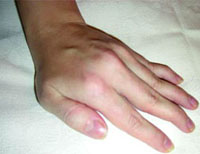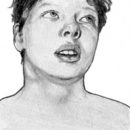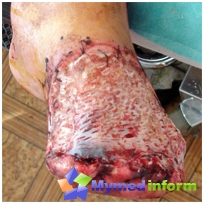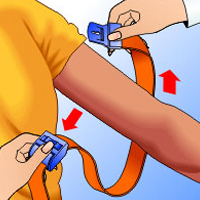Contracture delivers many trouble to its owner. However, these troubles are nothing compared with what the contracture can turn into absent in the absence of treatment. What are the contractures and what they are dangerous? - Answers to these questions you will find in this article.
Content
 Contracture - restriction of joint mobility due to pathological changes in soft tissues that are associated with the function of this joint.
Contracture - restriction of joint mobility due to pathological changes in soft tissues that are associated with the function of this joint.
If the joint is in the position of bending, the contracture is called a bending, extension - extensible, bringing - leading, leading - discharge, rotation - rotation contracture. The degree of violation of the functions of the joint and the range of movements in it characterizes the severity of contractures.
Contractures are divided into congenital and acquired. Congenital contractures are due to the underdevelopment of muscles (Krivoshoye), joints (closure) and skin («Swimming membranes»). These contractures) are rare.
The most frequently observed contractures. They are divided into traumatic, inflammatory, paralytic, dystrophic and fixative. In the contract, any one fabric amazed. In the future, the pathological process captures the remaining tissues adjacent to the joint. Contractures can be:
- Primary traumatic, due to reflex tension of muscles in response to impulses from damaged tissues.
- Pain Contracts caused by a persistent reflex increase in muscle tone in response to pain in a damaged segment.
- Pain Contracts caused by a persistent reflex increase in muscle tone in response to pain in a damaged segment.
- Muscular contractures forming with degenerative-dystrophic changes in the muscles or caused by the increment of a part of the muscles to the bones.
- Scar contractures, which are a consequence of the formation of scars with the involvement of the skin, subcutaneous fatty fiber, muscles.
- Arthrogenian contractures (articular) observed in atrophic-degenerative changes in the tissues of the joints.
- Osteogenic contractures (bone) are due to the deformation of bones, sharply limiting the volume of movements.
Joint contractures can develop after burns, closed and open fractures, muscle damage, tendons, nerves, vessels, and t.D.
Most often, contractures are mixed, t.To. Contracture, which initially arose as a result of changes in one tissue, subsequently leads to secondary changes in the tissues of the joint.
Resistant contracture of any origin in the absence of treatment can increase up to the complete loss of the mobility of the joint - Ankylosis.
In turn, ankylosis distinguish with:
- Bone - in which immobility in the joint is due to the bone fighting of articular articular ends. With bone ankylosis, bone beams pass through the zone of the former articular slot, connecting the joint ends of the bones to one whole; The articular gap is usually missing.
- Fibrous - resulting from fibrous, scar adhesions between the articular surfaces. When fibrous ankylosis, the articular gap is usually visible.
- An embracing - when the cause of immobility in the joint is the embracing formation of bone fusion between the joint bones or the ossification of the surrounding joints of the soft tissues during the preserved articular slot.
Thus, the need for timely treatment of contractures is obvious. For the treatment of contractures, therapeutic physical education, physiotherapy procedures, manual therapy, massage, applied exercises and a number of other methods.









